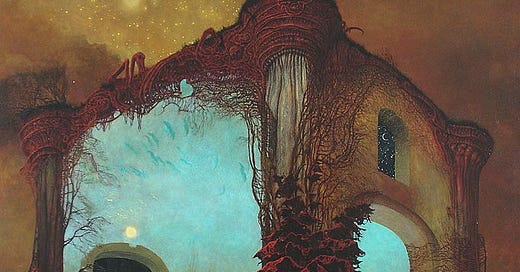Zdzislaw Beksiński and his intriguing works of art.
Life, Art, Anti-Philosophy and More by Zdzislaw Beksiński.
As I have already written in the note Zdislav Beksinski does not put labels, interpretations and titles to his paintings. He is a completely enigmatic artist with his enigmatic paintings, although he said that everything is very simple and he did not put anything psychological into his paintings.
"I don't really think about why I paint something, it kind of doesn't mean anything. It can happen completely by accident and I do it lightly."
The artiste is always simple, sweet and ironic with his answers in interviews with him.
Beksinski studied architecture at the Polytechnic University in Kraków before working in construction in his home small town of Sanok. In hatred of this life, he decides to pursue the path of art. Zdzisław Beksinski starts making sculptures from improvised materials such as plaster, wire, metal and others. He may have even taken materials from construction sites. Beksinski said he enjoyed making sculptures, but lacked the space and environment to create. So, at 20-plus years old in the '50s, a life as an artist full of art began.
Original source of the museum in Sanok for Zdisław Beksinski's sculptures: https://muzeum.sanok.pl/pl/zbiory/zdzislaw-beksinski/rzezba
Beksinski was bold and apparently found himself (i.e. his style) in art right away. All of his works of art were soul-touching, mesmerizing and macabre. Many of them touch on personal experiences and lead directly to their own psychological analysis.
His photographs are streamlined figures in a languid light, unusual and innovative portraits showing different emotions of different personalities, and an abstract vision of the world through Beksinski's eyes through his camera. If we go deeper, it is important to say that the artist took pictures with his father's camera at the beginning of the war, but they were not creative, as Zdzislaw Beksinski said. Perhaps those impressions and his one of the first photographs, i.e. the war had a strong impact on the artist's vision of the world.
Original source of the museum in Sanok on Zdzisław Beksinski's photos: https://muzeum.sanok.pl/pl/zbiory/zdzislaw-beksinski/fotografia
Beksinski said that his paintings are his personal perception of the world through the prism of creativity and that perhaps the reason for his painting lies in the darkness of his childhood. Having completely withdrawn from photography, the artist occupies himself with painting. The most surreal and unusual paintings, which do not leave indifferent viewers, and Beksinski himself were written in 70-80 years, and the period of these years he called Fantastic. The detail of these paintings is mesmerizing, the destruction of the painted world sticks in the soul, and fictional creatures and buildings do not leave without delight and surprise. Zdzislaw Beksinski said that his style is a combination of two - Baroque and Gothic. But in the 90s, the artist combines drawing with computer graphics and it comes out very original. Beksinski said that it gave him a completely different perspective. In his graphics he used his own or other people's photos, making collages of them with a scanner and then processed on the computer. Beksinski was excited about the artificial reality he could create, although I don't think he would be so excited about artificial intelligence now, because after a few years he returned to the traditional expression of himself through painting anyway.
Original source of Sanok Museum for Zdisław Beksinski's paintings: https://muzeum.sanok.pl/pl/zbiory/zdzislaw-beksinski/malarstwo
Original source of Sanok Museum for Zdisław Beksinski's drawings: https://muzeum.sanok.pl/pl/zbiory/zdzislaw-beksinski/rysunek
Original source of Sanok Museum for Zdisław Beksinski's computer graphics: https://muzeum.sanok.pl/pl/zbiory/zdzislaw-beksinski/grafika
“I want to write as if I were photographing dreams.”
Despite the apparent positivity of the artist in various interviews his life is not easy at all. This man survived the Second World War, which also affected his work. In the late 90s, his wife, who was his muse, dies after a long illness. A year later his son commits suicide, as if he had been living with a dark shadow all his life. Zdislav himself found his son's body.
The artist's last painting was painted in February 2005, which he signed as “Y”. https://www.getdailyart.com/ru/23899/zdzislav-beksinskiy/y
“Maybe I can still finish it today”. - written in his notebook and was about his last painting.
After finishing the painting, Zdzislaw Beksiński was brutally murdered allegedly for not lending 100 zlotys ($25) to the 19-year-old son of his assistant, he was stabbed 17 times.
No matter how much the author would like to and no matter how much he denies it, Zdzislaw Beksinski's work became a self-portrait of his soul or life, a kind of naked pain. Although I would like to adhere to the author's philosophy and not to label him.
At the moment, the second exhibition of Zdisław Beksiński's works is taking place in Warsaw until September 28. Warsaw was also home to the author, as he lived here too, although he lost his family in this very city.
Interesting things to delve into Beksiński's art or to merge with it:
-Virtual or real tour of the Beksinski Gallery in Sanoka
-De Profundis is an immersive VR experience created by Polyrain Studio (formerly 11th Dimension). Allows you to “walk” through surreal spaces, transporting the user inside selected paintings by Beksinski, surrounded by sounds and an atmosphere of unease.
-Albums with works by the author: “Beksiński 1-4”. A set of albums in a slipcase, "Beksiński. The Art of Painting".
-Documentary “Zdzisław Beksiński: ostatnia rozmowa” (2016).
-Book "Beksińscy. Portret podwójny" Grzebałkowska Magdalena.
-Official posters and graphics (A3) from the website shopbeksinski.com.
-T-shirt “Beksiński × Medicine” - collab with Polish brand, stylish and recognizable T-shirt with author's print.
How much effort and time the author devoted to his works of art. How can a person have such a deep stream of thoughts and how is he able to express it all on canvas?
What do Beksinski's paintings give you and what are they for you?




